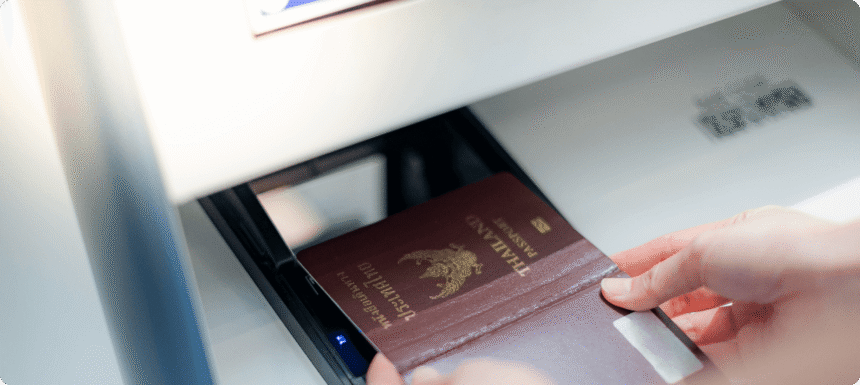OCR-based ID and passport scanning software represents an advanced technological solution that leverages Optical Character Recognition (OCR) to facilitate the automatic reading, extraction, and digitization of information from various physical identity documents. This includes essential items such as passports, national identification cards, driver’s licenses, and visas. By employing sophisticated algorithms, this software can accurately interpret the text and data embedded within these documents, converting them into a digital format that can be easily stored, processed, and analyzed. The implementation of such technology not only enhances efficiency in data handling but also significantly reduces the potential for human error, thereby streamlining processes in sectors such as border control, banking, and identity verification. As a result, organizations can improve their operational workflows while ensuring compliance with regulatory standards related to identity management and data security.
The software utilizes a scanner, webcam, or mobile camera to capture an image of an identification document, such as an ID card or passport. Following the image capture, it systematically identifies critical areas within the document, including the Machine-Readable Zone (MRZ), the Visual Inspection Zone (VIZ), and any embedded barcodes. This process allows the software to extract essential information, which encompasses the individual’s full name, ID Number or document number, Country of Issue, and date of expiry. Subsequently, the extracted data is transformed into a structured digital format, making it suitable for integration into various applications, including forms, databases, or automated systems, thereby enhancing efficiency and accuracy in data handling.
Key Features:
- Advanced Optical Character Recognition (OCR) software designed specifically for the efficient scanning of passports and similar identification documents. – Facilitates automatic data extraction, eliminating the need for manual data entry and significantly reducing the potential for human error.
- Compatible with a variety of identification formats, including passports, national IDs, and driver’s licenses, ensuring versatility in document processing.
- Capable of accurately reading Machine Readable Zone (MRZ) codes in compliance with the International Civil Aviation Organization (ICAO) Document 9303 standards, ensuring global compatibility.
- Offers seamless functionality across multiple platforms, including mobile devices, desktop computers, and cloud-based systems, providing flexibility for users in various environments.
- Supports a wide range of languages, making it suitable for processing documents from diverse linguistic backgrounds and enhancing its usability in international contexts.
- Incorporates advanced image processing techniques to enhance the quality of scanned documents, ensuring high accuracy in data capture.
- Features a user-friendly interface that simplifies the scanning process, allowing users to quickly and efficiently capture and manage identification data.
- Provides robust security measures to protect sensitive information during the scanning and data storage processes, ensuring compliance with data protection regulations.
- Regularly updated to incorporate the latest technological advancements and security protocols, ensuring that users benefit from the most current features and capabilities.
Top 10 Common Use Cases where OCR ID scanning
Here are the ten most common scenarios in which OCR ID scanning is extensively utilized. This technology is particularly valuable in various sectors, including banking, where it streamlines the process of verifying customer identities during account openings or loan applications. In the travel industry, OCR ID scanning enhances security and efficiency at check-in counters by quickly reading and validating passports and boarding passes. Retailers also benefit from this technology by using it to expedite age verification for restricted purchases, ensuring compliance with legal requirements. Additionally, healthcare providers employ OCR ID scanning to accurately capture patient information from insurance cards, reducing errors and improving the overall patient experience. In government services, this technology aids in the processing of applications for licenses and permits, making the workflow more efficient. Educational institutions utilize OCR ID scanning for student identification during exams, ensuring that the right individuals are being assessed. Furthermore, event organizers leverage this technology to manage ticketing and entry processes, allowing for a smoother experience for attendees.
Airports & Immigration
OCR ID scanning is a crucial technology utilized in airports and immigration processes to streamline the procedures of passport control, visa verification, and the logging of entry and exit at border checkpoints. This system enhances efficiency by quickly reading and processing identification documents, allowing for a smoother flow of travelers through security and immigration areas. By automating these checks, OCR ID scanning reduces wait times and minimizes human error, ensuring that border control agencies can maintain high levels of security while providing a more convenient experience for passengers. As a result, this technology plays a vital role in modernizing travel and enhancing the overall effectiveness of immigration operations.
Hotels & Hospitality
OCR ID scanning technology is revolutionizing the hospitality industry by streamlining the guest check-in process. By automatically capturing and extracting essential information from identification documents such as IDs and passports, this system significantly reduces the time guests spend waiting to check in. This not only enhances the overall guest experience by providing a quicker and more efficient service but also allows hotel staff to focus on other important tasks, improving operational efficiency. As a result, hotels can offer a seamless arrival experience, ensuring that guests feel welcomed and valued from the moment they step through the door.
Banks & Financial Institutions
Banks and financial institutions play a crucial role in implementing Know Your Customer (KYC) processes, which are essential for verifying the identities of their clients. This verification is a fundamental step in account opening procedures, ensuring that institutions have accurate information about their customers before establishing any financial relationship. Additionally, KYC practices are closely linked to Anti-Money Laundering (AML) compliance, as they help prevent illicit activities such as money laundering and fraud. By conducting thorough due diligence, banks can assess the risk associated with each customer, monitor transactions for suspicious activity, and maintain a secure financial environment. This comprehensive approach not only protects the institution but also fosters trust and transparency in the financial system.
Telecom Providers
OCR technology plays a crucial role for telecom providers, particularly in the processes of SIM card registration and customer onboarding. By utilizing national ID verification, telecom companies can efficiently authenticate the identity of their customers, ensuring compliance with regulatory requirements and enhancing security measures. This technology streamlines the onboarding process, allowing for quicker activation of services while minimizing the risk of fraud. As a result, customers experience a smoother transition when acquiring new SIM cards, and providers can maintain a reliable database of verified users, ultimately fostering trust and reliability in the telecommunications sector.
Government Services
Optical Character Recognition (OCR) technology plays a crucial role in government services, particularly within eGovernment portals. These digital platforms utilize OCR for the validation of identification documents, which is essential for various online services such as e-Visas, tax submissions, and welfare applications. By converting different types of documents, including scanned paper documents and images, into editable and searchable data, OCR enhances the efficiency and accuracy of processing applications. This technology not only streamlines the verification process but also improves user experience by allowing citizens to access essential services more conveniently and securely. As governments continue to embrace digital transformation, the integration of OCR will likely expand, further facilitating seamless interactions between citizens and public services.
Healthcare & Insurance
OCR technology plays a crucial role in the healthcare and insurance sectors by facilitating patient identity verification, streamlining insurance registration processes, and enhancing fraud prevention measures. By accurately capturing and processing data from various documents, such as identification cards and insurance forms, OCR helps healthcare providers ensure that patient information is both reliable and secure. This technology not only reduces the likelihood of errors during data entry but also accelerates the overall registration process, allowing professionals to give more focus on patient care. Additionally, by identifying inconsistencies or fraudulent activities in insurance claims, OCR contributes to safeguarding the integrity of the healthcare system, ultimately benefiting both providers and patients alike.
Car Rental & Travel Agencies
OCR software plays a crucial role in enhancing the efficiency of car rental and travel agencies by enabling rapid customer verification during the booking or vehicle rental process. This technology allows businesses to quickly scan and process identification documents, such as driver’s licenses and passports, ensuring that customer information is accurately captured and verified in real-time. By streamlining this verification step, agencies can significantly reduce wait times for customers, improve overall service quality, and minimize the risk of fraud. As a result, both customers and agencies benefit from a smoother, more secure transaction experience, ultimately leading to higher satisfaction and loyalty.
Educational Institutions
OCR software plays a crucial role in educational institutions by streamlining processes such as student registration, exam identification, and secure access to campus facilities. By utilizing optical character recognition technology, schools and universities can efficiently convert printed documents into digital formats, making it easier to manage student records and verify identities during examinations. This not only enhances the accuracy of data entry but also significantly reduces the time and effort required for administrative tasks. Furthermore, the implementation of OCR solutions contributes to improved security measures on campus, ensuring that only authorized individuals can access certain areas, thereby fostering a safer learning environment for students and staff alike.
Events & Venue Access Control
OCR software plays a crucial role in managing access control for events and venues, particularly those that require identity verification and credential issuance. This technology enables organizers to efficiently validate attendees’ identities, ensuring that only authorized individuals gain entry to secure or ticketed events. By scanning and interpreting printed or handwritten text from identification documents, OCR software streamlines the check-in process, reduces wait times, and enhances overall security. Its ability to quickly process large volumes of data makes it an invaluable tool for event planners, allowing them to maintain a smooth flow of guests while safeguarding against unauthorized access.
Retail & E-commerce (Age Verification)
OCR software plays a crucial role in the retail and e-commerce sectors, particularly for age verification processes. This technology is essential for confirming the identity and age of customers purchasing age-restricted products, such as alcohol and tobacco. By scanning and interpreting information from government-issued identification documents, OCR software ensures that retailers comply with legal requirements and prevent underage sales. This not only protects businesses from potential legal repercussions but also promotes responsible consumption among consumers. As online shopping continues to grow, the integration of OCR technology becomes increasingly important for maintaining security and trust in digital transactions.
Comprehensive Solutions: Passport Scanners with OCR Technology
A comprehensive passport scanning solution combines various elements to streamline the process of document verification. At its core, it includes specialized hardware such as a document scanner or a mobile camera, paired with advanced Optical Character Recognition (OCR) software that extracts essential information from the Machine-Readable Zone (MRZ), Visual Inspection Zone (VIZ), barcodes, and embedded chips in ePassports. Additionally, the system features verification modules that not only validate the extracted data but also detect potential forgeries and, in some cases, perform biometric facial recognition to enhance security.
The main components of this solution consist of a high-resolution passport or ID scanner that captures detailed information from various document formats, an OCR engine that organizes data such as names, dates of birth, nationalities, and expiration dates, and an authentication module that checks the document’s authenticity through various methods, including watermark and UV/IR detection. Optional features may include biometric matching, which compares the passport photo to a live selfie, and API/SDK integration that facilitates smooth connectivity with third-party applications like customer relationship management systems, border control systems, and hotel property management systems.
Several reputable hardware brands are known for their passport scanning solutions, including ARH, which specializes in combo scan and PRMc passport scanners, and Gemalto (Thales), recognized for its full-page readers that support chip and OCR technology. Other notable brands include Regula, which offers high-end forensic document readers, Desko, known for compact ID and passport readers suitable for kiosks, Access IS, which provides kiosk-ready ID document readers, and Acuant, which focuses on ID capture and document verification platforms.
A complete passport scanning solution boasts several key features, such as the ability to read various MRZ formats (TD1, TD2, TD3), capture RFID data from ePassports, and read both sides of national IDs and driver’s licenses. It supports documents from over 200 countries and offers multi-language OCR recognition, including languages like Arabic, Russian, and Chinese. Furthermore, the solution ensures secure data encryption and compliance with GDPR regulations, incorporates auto-capture and blur detection capabilities, and includes facial comparison technology for identity verification using a selfie camera.
These advanced scanning solutions are utilized across a variety of industries, including airports and border control, hotels and travel agencies, banks and insurance companies, telecommunications, government and embassy services, healthcare facilities, and educational institutions.
The benefits of integrated passport scanning solutions are significant, offering rapid and automated check-in processes that enhance customer experience


